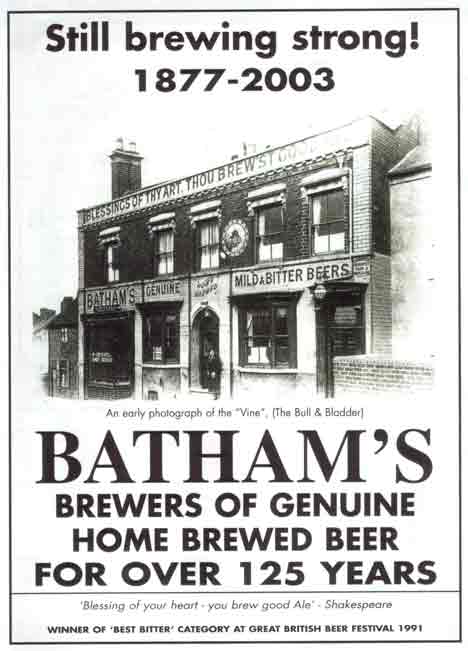
defunct@breweryhistory.com

Those with a long memory will recall that the last Defunctimissive addressed the topic of ceramic plaques. This produced a considerable response which, I feel, justifies a composite paper. I have taken the liberty of including a few examples where the breweries are, thankfully, not defunct.
Whilst I shall continue to refer to these items as plaques, it would appear that they were known in the trade as brewers’ ‘housemarks’. This is substantiated by photographs of the Greene King plaques in a 1950 edition of the Royal Doulton trade press. (RF)
Many of the entries within the Defunct Brewery Livery project are in respect of such plaques.
The Breweries that consistently displayed such ceramic plaques so far recorded are:
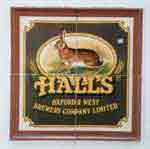 Whilst
Halls Oxford Brewery Co Ltd can trace its history back to 1646, it was acquired
by Allsopp & Sons Ltd in 1928. Ind Coope resurrected the company as above in
1980.
Whilst
Halls Oxford Brewery Co Ltd can trace its history back to 1646, it was acquired
by Allsopp & Sons Ltd in 1928. Ind Coope resurrected the company as above in
1980.
The reasonably large number of plaques, still to be seen in Oxford, date from this time. Although relatively modern they are attractive and worthy of recording. (The illustration is from “Britannia”, Headington, Oxford.)
Allsopps/Ind Coope continued to utilise Hall’s livery on pubs built in the 1930s and some of this remains.
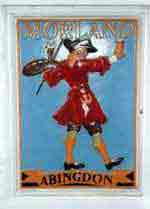
Produced by Poole Pottery or associated Carter Tile Works (RF)
Designed by Reginald Bell (RF)
As the company has only recently joined the defunct status there are many of these still in place in the Abingdon hinterland.
They are extremely colourful as befits the artist depicted. Quoting from the brochure produced for the shareholders on the occasion of the 250th anniversary:
‘An interesting connection of the Morland family with the famous 18th century artist of the same name is still preserved by the Company’s Trade Mark, which depicts a painter of that period.’
I am advised that there were, at least, two editions. One of the early ones is, I believe, at the North Star at Steventon, Nr Abingdon. (The photograph is of that particular plaque). If I am correct the colours are stronger on the earlier editions. Fortunately the pub has re-opened following its New Year 2003 experience. It is listed in CAMRA’s National Inventory of Historic Pub Interiors and is very worthy of a visit
Also at Steventon, inside the Fox, is a metal plaque, which certainly has variations and appears to predate the ceramic plaques.
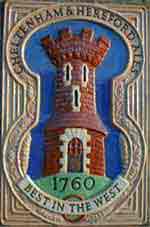
Manufactured by Doultons of Lambeth (LP)
West Country Breweries was the name adopted following the merger of The Cheltenham and Hereford Breweries with The Stroud Brewery Co Ltd in 1958. Acquired by Whitbread and Co Ltd in 1963. Cheltenham and Hereford Breweries Ltd was a result of a merger in 1945.
A magnificent plaque with the castle trademark which is still quite prevalent in the West Country. It was formerly the trademark of The Cheltenham and Hereford Breweries Ltd and a plaque of that company remains at the Ex - Foxhill Inn at Guiting Power, Gloucestershire. (As illustrated).
Geoff Sandles possesses a wealth of information on breweries and pubs in Gloucestershire and has a website – www.gloucestershirepubs.co.uk
Acquired by Whitbread and Co Ltd in 1965 with 354 public houses and brewery was closed in 1968.
Between the wars Lacons brewery was one of the few which continued to use decorative ceramics on their pubs, partly because of the enthusiasm of their in-house architect A.W. ‘Billy’ Ecclestone, who designed pubs in both neo-vernacular and modern styles. For the former he had bricks and tiles specially made by the Sommerleyton Brick Company and Tucker’s of Loughborough respectively, while his modern pubs – for instance the Clipper Schooner built in 1938 – almost always sported a tiled panel by Carter’s of Poole, which acted as a pub sign; these panels continued to be manufactured for Lacons into the 1950’s. (LP)
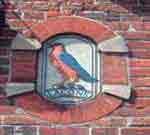
The Lacon plaques appear on various parts of the buildings, often quite high up on the wall, which differs from most breweries that placed theirs adjacent to the entrance. (Illustration from “White Horse Inn”, Great Yarmouth.)
Of the many examples that have been recorded and photographed there are one or two irregularities:
First & Last, Lowestoft – whereas invariably the falcon faces to the left, at this pub it faces to the right.
The Marine – Great Yarmouth – the hues of this falcon are blue and gold and differ from the normal blue and a shade of pink.
Derek Taylor has been doing sterling work in Norfolk and Suffolk and has recorded an extraordinary amount of Lacon livery.
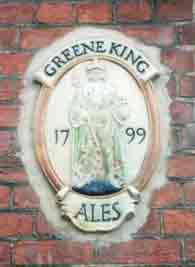
Designed by the late Kruger Gray in 1933 (RF) (LP)
A polychrome stoneware plaque, produced by Doultons of Lambeth and after the closure of the Lambeth works in 1956 by Poole Pottery/Carters Tile Works (RF) (LP)
The brewery is, of course, far from defunct, but the information supplied by Robert Flood is both fascinating and informative:
‘If you want an oblique brewery reference that appears on a number of pubs in the area then some of the Greene King stoneware wall plaques have a reference to a former Cambridge brewery. The plaques come in four flavours, the difference being in the scroll at the feet of the figure. This can read “Fine Suffolk Ales”, “Fine Cambridge Ales”, “Ales” or “Fine Ales”. The plaques seem to have been produced originally in the 1930s but the “Fine Cambridge Ales” refers back to the Panton Brewery of Bailey & Tebbutt taken over by Greene King in 1925. By the mid 1930s this brewery was being referred to as Greene King’s Cambridge Brewery. The “Cambridge” plaques only ever went onto former Bailey & Tebbutt pubs, other pubs owned at the time, even in Cambridge, got “Suffolk” plaques. When Wells & Winch were taken over in the early 1960s their pubs got “Ale” plaques, and I think that “Fine Ales” are modern. Don’t know what went on to Simpson or Ogden pubs, I’ll have to check. The “Cambridge” plaques are still to be seen on ex B&T pubs, for example Bird in Hand, Free Press, Hopbine and Champion of the Thames in Cambridge, Black Bull and Three Tuns in Willingham etc.'
'The Greene King plaque story is getting a little complicated. The ‘Ales’ plaques may have gone onto any pub that they acquired in the same period that they took over Wells & Winch. Also they are very possessive about them and the plaques are the first things they remove when they are going to close a pub. This means that they have an assorted stock of plaques and I suspect that they are being used at random on pubs they acquire outside their traditional trading area. Even in Cambridge a Suffolk Ales plaque has just been used to replace a damaged Cambridge Ales plaque on an old B&T pub.’
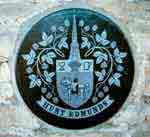
Richard Queralt has recorded several circular plaques for this brewery where brewing ceased in 1967.
There are two versions which are identical apart from the colours.
The detail is the same on both. The obelisk is Banbury Cross, a market cross on the main road through the town. The lady on the horse is the ‘Fine Lady’ of Ride a Cock Horse nursery rhyme fame. She was probably a member of the Fiennes (Fiennes lady) family and related to Lord Saye and Sele of nearby Broughton Castle.
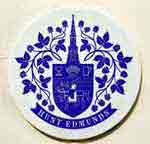
As regards Richard Queralt's Hunt & Edmunds plaques, Bass Charrington revived the Hunt, Edmunds name for their large hotels division (although possibly only in their South-West division), and the slate grey plaques with the pearl grey motif are theirs. There used to be one on the Half Moon at Sherborne, and I photographed one many moons ago on an unidentified hotel in Exeter. I wonder if the other plaques, the Delft like blue and white ones, are from the brewery's independent days?'
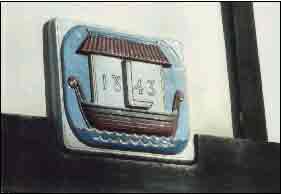
Still brewing.
Prototype plaque based on the idea of one of the directors, was executed by Mr Heber Matthews and exhibited at the Central Institute of Art & Design in 1948 but the final colour scheme had not been decided. The final design was in production at Royal Doulton by 1952 (RF)
These attractive plaques were once quite common with many breweries commissioning production for their tied estates. Unfortunately they have become collector’s items and they are fast disappearing, either illegally or publicans are moving them inside for added security.
Ray Farleigh writes: “I cannot be certain about the precise dates for the Brilliant Sign Co though they must be out there somewhere. I think there’s little doubt that their heyday was in the years between the wars, and I found trade ads for the company from 1930 & 1936, then delving a little deeper I unearthed a copy of an advert of The Brilliant Sign Co Ltd from the Brewers Gazette for November 1925 showing a Hodgson’s Kingston Brewery tablet ‘fixed 8 years ago’ which pushes it back to 1917. They were operating from Paragon Works, Shepherds Bush and described themselves as the oldest established firm in the Kingdom, but the claim ‘Slate Tablets Entirely Superseded’ and the catalogue of advantages claimed for the Durasign tablet suggest that it was a comparatively recent development. The enamelled slate tablets which preceded them went back quite a bit further, and I have a copy advert of 1896 for the Ashton & Green Iron Co’s marble and slate works at Farringdon Wharf, Stratford E. showing them being hand made.”
In Dorset and adjacent counties there is still a handful of Devenish Brilliant Sign Co plaques.
Nigel Clubb advises that there are two versions of this plaque: